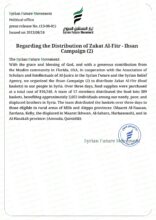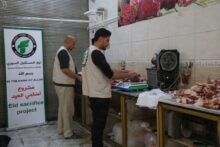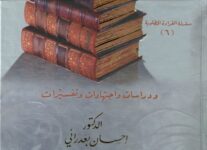The Syrian Solution through the Gateway of Economy

The political situation in Syria is complex, likely due to the international community’s inertia in finding a way to implement UN resolutions or even creating any Syrian-Syrian settlement. The overall situation in Syria is complicated by the intervention of multiple foreign powers; there are at least four foreign armies involved.
The areas of influence are divided into four regions, each suffering from a collapsed economy. Addressing this economic collapse may serve as a gateway to a political solution and break the deadlock.
Economic Situation in the Four Regions:
Economy in Syrian Government-Controlled Areas:
The economy in these areas faces significant challenges and multiple crises. Generally, the economic situation is as follows:
- General Economic Crisis: This began after the outbreak of the Syrian revolution in 2011, leading to many regions falling out of the Syrian government’s control, significantly impacting the economy. Resources were distributed among various mafias and militias.
- Public Revenue Decline: With increased military expenditures, the country’s resources were destroyed, converting economic potential into sources of sustained violence. Since the crisis began, the Syrian government’s economic losses have exceeded $400 billion according to some reports.
- Currency Collapse and Living Costs: The exchange rate has plummeted to record levels against the dollar, weakening purchasing power and increasing living costs. There is also a shortage of medicines and essential goods, with more than 9.3 million Syrians in government-controlled areas at risk of hunger according to relief reports.
- Shadow Economy and Complex Challenges: The shadow economy in Syria is intricate, with the Syrian government attempting to legitimize it through laws that weaken the state’s ability to counter it.
- COVID-19 and Caesar Act Economic Impact: These have tightened economic sanctions on the Syrian government and its symbols.
Economy in Self-Administration Areas in Eastern Syria:
This region also faces multiple challenges and a complex situation:
- Previous Marginalization: Before the Syrian revolution, the industrial sector in northeastern Syria was economically marginalized, with strict governmental restrictions on establishing factories, negatively impacting economic development. Corruption and bureaucratic complexity also hindered the establishment of new factories.
- Post-Self-Administration Control: The industrial sector has seen significant progress, with many factories and industrial establishments being opened, addressing a previously unmet need. Since 2011, 256 production plants have been established in self-administration areas.
- Current Challenges:
- Deteriorating Infrastructure and Economic Blockade: These are significant obstacles to economic development.
- Turkish Attacks and Syrian Government Policies: These affect the availability of raw materials and goods in the region.
In summary, while the self-administration is facing economic challenges, it strives for self-sufficiency and industrial development.
Economy in Hay’at Tahrir al-Sham-Controlled Areas in Idlib:
The economy here faces multiple challenges due to complex political and economic conditions:
- Control over Economic Resources: Hay’at Tahrir al-Sham controls key commercial crossings in Idlib, whether connecting to Syrian government-controlled areas or Turkey. The Bab al-Hawa border crossing is a vital resource for those who control it, financing them and increasing their authority.
- Current Economic Challenges: These include high living costs and a deteriorating economic situation. There is also a noticeable spread of private schools and religious schools monitored by Hay’at Tahrir al-Sham.
- Economic Control Struggle: Hay’at Tahrir al-Sham aims to dominate all economic resources in the region, leading to clashes with other factions. Control over the economy can affect military control in the province. There is a noticeable boom in construction and real estate sectors, more so than in other Syrian regions. The area under Hay’at Tahrir al-Sham is considered one of the most organized and governed.
Economy in the Syrian Interim Government Areas in Northwestern Syria:
These areas suffer from significant economic challenges due to complex political and economic conditions:
- Turkish Lira Fluctuations: Northern Syria has experienced severe economic shocks repeatedly. After the Syrian pound’s collapse in mid-2020, these areas adopted the Turkish lira. The instability of the Turkish lira in the second half of 2021 had a negative impact on the local economy.
- High Prices and Low Purchasing Power: Prices remain high, and wages are low, leading to a potential large-scale humanitarian crisis. Despite the Turkish lira’s recovery against the dollar, prices are still high, and workers’ wages are deteriorating. Another shock is expected with the anticipated collapse of the Turkish currency.
- Additional Challenges: These include political corruption, nepotism, tribalism, and the lack of governance and institutional work, hindering economic improvement.
Economy as a Potential Solution:
Political economy studies the complex relationship between politics and economics, aiming to analyze how political institutions and economic systems interact to shape social and economic outcomes. The study of political economy dates back to ancient Greece, influenced by various thinkers and theories. I previously laid the groundwork for this article in another titled: “Economy as a Factor for Political Change in Syria.”
Political economy helps understand the interactions between politics and economics and can be a positive factor in an economically collapsed country like Syria through:
- Policy Analysis: Provides an accurate assessment of economic policies and their impact on people and society, guiding public policy to achieve specific economic goals.
- Understanding Economic Systems: Helps analyze how economic systems work and their impact on people, contributing to the development of fairer and more sustainable economic models.
- Economic Justice Determination: Helps determine how wealth and opportunities are distributed among people, contributing to greater balance in opportunities and resources.
Thus, political economy remains a tool for achieving political solutions by understanding the interactions between politics and economics and guiding public policy. In Syria, political economy is a core part of the country’s challenges. The Syrian Future Movement (SFM) believes that the political deadlock can be broken through the economic gateway. Therefore, we recommend focusing on the economy, especially in areas outside Syrian government control, to become a refuge for Syrians instead of foreign countries. This can be achieved by attracting projects, opening factories, and providing good-paying jobs. This alone would undermine the Syrian government’s refugee card, encouraging their return from neighboring countries on solid ground, compelling the government to accept a political solution.
Solving the economic crisis can contribute to social and political stability by creating job opportunities and reducing tensions, fostering stability. International and regional cooperation in supporting the Syrian economy can be part of a comprehensive solution.
In summary, the Syrian economy can be a driving force toward a political solution by achieving stability and sustainable development, especially in areas outside Syrian government control. As for government-controlled areas, they are unlikely to benefit from any economic reforms due to Western sanctions and rampant corruption.
Inas Nasr El-Din
Economic Office
Research and Studies Department
Syrian Future Movement (SFM)
References:
(1) الاقتصاد السياسيّ في سوريا: ترسيخ توجّهات ما قبل الحرب.
(2) اقتصاد سوريا بعد عقد من الحرب.. الحلول لا تزال غائبة.
(3) بعد عقد على الثورة.. الاقتصاد السوري في القاع واقتصاد الظل يتمدد في ….
(4) السياسات الاقتصادية في سورية من التهميش إلى الثورة.
(5) الأزمة الاقتصادية في سوريا: توليفة من الأسباب الداخلية والخارجية.
(6) الاقتصاد السياسي: مفهومه وأهميته وأهدافه ونظرياته.
(7) كيف يمكن أن يكون الاقتصاد المحرك الأساسي للحياة؟ – مركز مسارات ….
(8) الاقتصاد السياسي العربي: مسارات نحو النمو العادل.
(9) الواقع الاقتصادي في الشمال السوري وتأثره بحالة التذبذب في الليرة ….
(10) خبير يكشف حقيقة الواقع الاقتصادي شمال سوريا رغم إعفاءها من “قيصر ….
(11) الواقع الإقتصادي في شمال سوريا – ACU.
(12) مؤتمر الاستثمار.. محاولة حكومية للارتقاء بالواقع الاقتصادي ولفت الأنظار ….
(13) مرصد الاقتصاد السوري، شتاء 2022 / 2023 – World Bank.
(14) الواقع الاقتصادي في شمال وشرق سوريا (تداعيات جائحة كورونا وقانون قيصر ….






